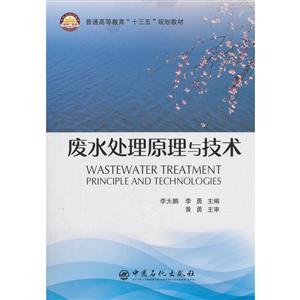Chapter1. Overview of wastewater 1
1.1 What is wastewater 1
1.2 The types of the wastewater 2
1.2.1 Domestic wastewater 2
1.2.2 Industrial wastewater 13
1.2.3 Rural wastewater 27
1.3 The effects of the wastewater 42
1.3.1 Chemistry of water impurities 42
1.3.2 Metallic Corrosion 46
1.3.3 Scale Formation 51
1.3.4 Fouling 51
1.4 Wastewater treatment processes 53
1.4.1 Preliminary and primary treatment 54
1.4.2 Secondary (biological) treatment 59
1.4.3 Tertiary (advanced) treatment 72
Chapter 2. Treatment theory of the activated sludge 81
2.1 The traditional activated sludge 81
2.1.1 The basic conception and the process 81
2.1.2 The forms and component of the activated sludge 82
2.1.3 The microorganism in the activated sludge and its function 83
2.1.4 The clarification process by the activated sludge 85
2.1.5 The effect of the environmental factors on the activated sludge 87
2.2 Some performance indexes of the activated sludge 93
2.2.1 Some performance indexes of the activated sludge 93
2.2.2 Some indexes of the activated sludge for designment and running 97
2.2.3 Aeration 100
2.3 The development and application of the activated sludge 104
2.3.1 Completemix activated sludge process 104
2.3.2 Tapered aeration process 105
2.3.3 Contactstabilization activated sludge 106
2.3.4 Highpurity oxygen activated sludge 108
2.3.5 Stepfeed activated sludge 109
2.3.6 Extended aeration activated sludge 110
2.3.7 Highrate activated sludge 111
2.3.8 Selector activated sludge 111
2.3.9 The running parameters for the traditional activated sludge and modified processes 113
2.4 The cultivation and running management of the activated sludge 114
2.4.1 The cultivation of the activated sludge 114
2.4.2 The running of the activated sludge 115
2.5 The abnormal phenomenon during the running of the activated sludge 117
2.5.1 Sludge bulking 117
2.5.2 Sludge disintegration 119
2.5.3 Sludge corruption 120
2.5.4 Sludge floating 120
2.5.5 Bubbles 120
2.5.6 Abnormal biofacies 121
2.5.7 Insufficient nitrification 122
2.5.8 Insufficient denitrification 122
2.6 The designment of the activated sludge 123
2.6.1 The calculation and designment on the aeration tank 123
Chapter 3. The biofilm 126
3.1 The basic concepts 127
3.1.1 The formation of the biofilm and the clarification 127
3.1.2 The carrier of the biofilm 130
3.1.3 The characteristics of the biofilm 131
3.1.4 The biofilm reactor 133
3.2 Some important parameters 134
3.2.1 Specific increase rate of biomass 134
3.2.2 Specific removal rate of the substrate 135
3.3 Biofilters 135
3.3.1 The definition of the biofilter 136
3.3.2 Trickling filter 138
3.3.3 Highrate filter 140
3.3.4 Tower biofilter 145
3.3.5 Biological aerated filter 148
3.4 Rotating Biological Contactor 152
3.4.1 The overview 152
3.4.2 The principle and the application 152
3.4.3 The designment of the rotating biological contactor 156
3.5 Submerged Biofilm Reactor 157
3.5.1 The structure 158
3.5.2 The form of the aeration tank 160
3.5.3 The characteristics of the submerged biofilm reactor 163
3.5.4 The processes of the submerged biofilm reactor 163
3.5.5 The designment of the submerged biofilm reactor 165
3.6 Biological fluidized bed 166
3.6.1 The structure 166
3.6.2 The characteristics 168
3.6.3 The process type of the biological fluidized bed 169
3.6.4 The designment of the biological fluidized bed 171
3.7 The new biofilm reactor and combination process 173
3.7.1 Combined biofilm reactor 173
3.7.2 Union process of biofilm and activated sludge 175
Chapter 4. Typical treatment processes 177
4.1 For domestic wastewater 177
4.1.1 Oxidation Ditch 177
4.1.2 Sequencing batch reactor 195
4.1.3 Membrane Bioreactor 211
4.1.4 Adsorption biodegradation 214
4.1.5 Moving Bed Biofilm Reactor 216
4.1.6 A/O process 218
4.2 For Industrial Wastewater 238
4.2.1 Anaerobic Biological Treatment 239
4.2.2 Upflow Anaerobic Sludge Blanket Reactor 250
4.2.3 The other typical technologies 253
4.3 For Rural Wastewater 261
4.3.1 Oxidation lagoon 261
4.3.2 The wetlands 273
Chapter 5 Control and use on sludge 280
5.1 Overview 280
5.1.1 The principle for the sludge treatment 280
5.1.2 The basic method for the sludge treatment 282
5.1.3 The basic process for the sludge treatment 282
5.2 Kinds, characteristics and calculation 282
5.2.1 The component and the kinds of the sludge 282
5.2.2 The indexes of the sludge 283
5.2.3 The calculation on the sludge amount 287
5.3 Sludge thickening 288
5.3.1 The gravity thickening 289
5.3.2 The flotation thickening 290
5.4 Sludge digestion 291
5.4.1 Anaerobic digestion 291
5.4.2 Aerobic digestion 292
5.5 Sludge conditioning 293
5.5.1 Chemical conditioning 293
5.5.2 Heat conditioning 294
5.5.3 Elutriation conditioning 294
5.5.4 Freezing solution conditioning 294
5.6 Sludge dewatering 295
5.6.1 The natural drying of sludge 295
5.6.2 The mechanical dewatering of sludge 295
5.7 Sludge drying and incineration 299
5.8 Comprehensive utilization and ultimate disposal of the sludge 300
Chapter 6. Wastewater Treatment Cases 301
6.1 Traditional activated sludge 302
6.2 Anaerobicaerobic activated sludge process 303
6.2.1 Anaerobicaerobic activated sludge process for removal P 303
6.2.2 Anaerobic/Anoxic/aerobic process 304
6.3 Adsorption/biodegradation process 305
6.4 Oxidation ditch process 306
6.4.1 AE oxidation ditch 306
6.4.2 T oxidation ditch 308
6.2.5 Biological aerated filter 311
6.2.6 A domestic example of reconstruction and extension of sewage plant 312
Chapter 7. Water Reclamation and Reuse 355
7.1 Water reclamation 356
7.2 Current and potential future global water shortages 359
7.2.1 Irrigation Water Use 360
7.2.3 Domestic and Industrial Water Uses 360
7.3 The important role of the water reclamation and reuse 361
7.4 Technology development 366
7.4.1 Typical water reclamation processes 368
7.4.2 Complete flow scheme optimizing for water reuse 371
7.5 Framework for water reuse implementation 376
7.6 Cases 377
7.6.1 Water reuse in China 377
7.6.2 The others 390

















